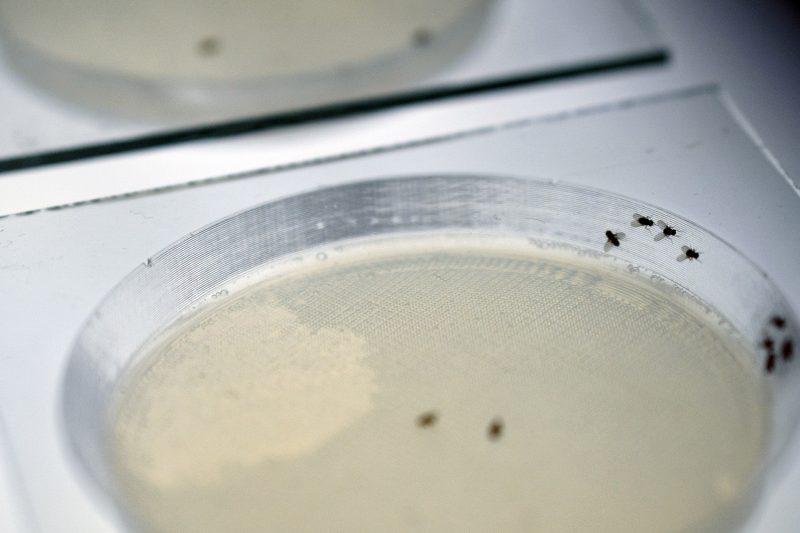
Fruit flies keep each other up
The party never stops
‘Look at this guy!’ PhD student Adithya Sarma exclaims. He points to a fruit fly that’s zigzagging across the floor of a round ‘mini arena’. The same container, which measures approximately eight centimetres across and is 1.2 centimetres high, houses nine other flies, some of which are having a peaceful snooze.
Then, the original fly stops zigzagging and makes a beeline for two of his sleeping cohorts. He taps them ever so quickly, gone again in a fraction of a second. But it’s enough to wake the sleeping fruit flies and spur them into action.
It’s a unique recording: never before had these fruit flies been observed playing ‘tag’. But neurobiologist Sarma created a system that allowed him to be the first person to observe fruit fly behaviour over the course of several days. He hoped this would give him more insight into the impact social interaction between the flies has on their sleep.
That’s because social interaction and sleep are inextricably linked, both in fruit flies and in people. ‘Take the lockdowns we had during the height of the Covid pandemic’, Sarma explains. ‘People started feeling really lonely and it affected their sleep.’ But no one quite knows why that is or how it works.
Social behaviour
Sarma thinks fruit flies can help him gain more insight into the matter. After all, people share a large part of their genes with fruit flies. But in fruit flies, scientists can switch these on and off in an effort to find out which genes and cell networks control which behaviour. ‘You can’t do that with people.’
They suddenly realised how tired they were when I removed them from the group
During his master project, he realised that fruit flies are profoundly social animals. He was trying to find out if lonely female fruit flies would pick other partners than the females who lived in a group. Sarma observed that the isolated females were ‘less picky’: they were more receptive to mating with males who weren’t great courters.

‘That meant they had characteristics that allowed them to pick their partners’, he says. ‘It was clear to me that social behaviour in fruit flies could be studied.’
A lot of sleep
This laid the basis for his PhD research, because Sarma also wanted to know if and how the fruit flies’ social interaction impacted their sleep: do fruit flies who spend all day alone sleep differently than the ones who spend it with their peers?
He put twenty fruit flies in a group and isolated a few others. After several days, he put each fly in an individual tube and started monitoring their sleep patterns.
He soon noticed that the fruit flies who’d spent time in a group slept a lot more than the isolated ones. ‘When I removed them from the group, it’s like they suddenly realised just how tired they were.’
Self-built system
What made the flies so tired, though? He couldn’t quite figure it out, and there was no system in place that could measure the behaviour of more than one fruit fly at a time. ‘No one was able to observe what happened when fruit flies were placed in a group for several days on end’, says Sarma.
It’s as if the flies need to relax after a night of partying
He decided to combine existing software with his own scripts, using a 3D printer to build ‘cool arenas’. These arenas are round and low, forcing the flies to move across the floor instead of flying. He positioned cameras above the arenas to film the fruit flies, and his system tracked whether they were active or asleep.

He was the first biologist ever to observe that flies slept less in groups than if they were isolated. ‘But why?’ Sarma wondered. His self-built system didn’t show that the fruit flies were in contact with each other at night. So what was keeping them awake?
Wake-up response
‘Perhaps they were having interactions that my system didn’t classify as social interactions’, Sarma recalls. ‘In biology, an interaction is considered social if the flies spend at least one and a half seconds near each other. But perhaps there were shorter interactions that kept the flies awake.’
Maybe it’s their turns to watch out for predators
He decided to take another look at his videos. ‘We found something really cool’, he says. The fruit flies would tap each other awake in what they realised were really short, quick interactions. ‘We thought it was really funny. Were these flies genuinely waking each other up?’
The researchers called it the ‘wake-up response’, mainly because they couldn’t come up with a better one, he grins. The interactions last less than half a second, but they do interfere with the fruit flies’ sleep.
‘Then, once they went back into isolation, they wanted to sleep for an entire day. It’s almost as if fruit flies have to take some time to relax after a night of partying, just like people.’
Everything has a function
So far, Sarma can only speculate on the function of the flies tapping each other awake. ‘Perhaps they’re waking the others up to tell them that it’s their turn to watch out for predators. Or maybe they just like messing with each other. We don’t know. But’, he adds, ‘biologists are taught that everything has a function.’
All he has to do is figure out what that function is. Less sleep might be considered a drawback, but perhaps that’s not true for the fruit flies, he suggests. ‘It’s possible that they’re getting enough sleep, and that more doesn’t equal better in their case.’